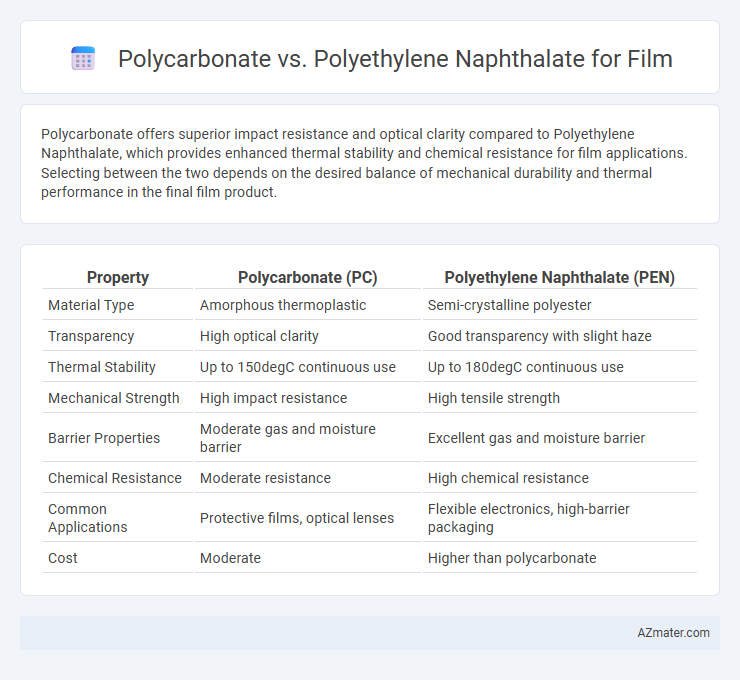Polycarbonate offers superior impact resistance and optical clarity compared to Polyethylene Naphthalate, which provides enhanced thermal stability and chemical resistance for film applications. Selecting between the two depends on the desired balance of mechanical durability and thermal performance in the final film product.
Table of Comparison
| Property | Polycarbonate (PC) | Polyethylene Naphthalate (PEN) |
|---|---|---|
| Material Type | Amorphous thermoplastic | Semi-crystalline polyester |
| Transparency | High optical clarity | Good transparency with slight haze |
| Thermal Stability | Up to 150degC continuous use | Up to 180degC continuous use |
| Mechanical Strength | High impact resistance | High tensile strength |
| Barrier Properties | Moderate gas and moisture barrier | Excellent gas and moisture barrier |
| Chemical Resistance | Moderate resistance | High chemical resistance |
| Common Applications | Protective films, optical lenses | Flexible electronics, high-barrier packaging |
| Cost | Moderate | Higher than polycarbonate |
Introduction to Polycarbonate and Polyethylene Naphthalate Films
Polycarbonate films are known for exceptional impact resistance, optical clarity, and thermal stability, making them ideal for applications requiring durability and transparency like protective screens and optical lenses. Polyethylene naphthalate (PEN) films offer superior chemical resistance, high thermal endurance, and excellent dimensional stability, commonly used in flexible electronics, packaging, and insulating films. Both materials serve specialized roles in advanced film technologies, with polycarbonate emphasizing toughness and clarity, while PEN excels in chemical and thermal performance.
Chemical Structure Comparison
Polycarbonate (PC) is an amorphous polymer composed of bisphenol A units linked by carbonate groups, featuring rigid aromatic rings that provide high impact resistance and thermal stability. Polyethylene Naphthalate (PEN) is a semi-crystalline polyester derived from naphthalene dicarboxylic acid and ethylene glycol, characterized by fused aromatic rings that enhance barrier properties and dimensional stability. The key chemical distinction lies in PC's carbonate linkage versus PEN's ester bonds, influencing their mechanical properties, thermal resistance, and suitability for film applications.
Mechanical Properties: Strength and Flexibility
Polycarbonate (PC) exhibits exceptional impact resistance and high tensile strength, making it ideal for applications requiring durability and toughness in films. Polyethylene Naphthalate (PEN) offers superior dimensional stability and excellent flexibility combined with high mechanical strength, suitable for films needing resistance to deformation under stress. Comparing the two, PC provides greater rigidity and impact resistance, while PEN balances strength with enhanced flexibility and thermal stability for specialized film applications.
Optical Clarity and Transparency Differences
Polycarbonate film offers exceptional optical clarity with a high light transmission rate of approximately 88-90%, making it ideal for applications requiring superior transparency and visual sharpness. In contrast, Polyethylene Naphthalate (PEN) provides good transparency but with a slightly lower light transmission rate around 85-87%, often exhibiting better ultraviolet (UV) resistance and dimensional stability. The choice between Polycarbonate and PEN films depends on balancing the need for optical clarity against factors like UV durability and mechanical performance.
Thermal Stability and Heat Resistance
Polycarbonate offers high thermal stability with a glass transition temperature (Tg) around 147degC, enabling it to maintain structural integrity under moderate heat. Polyethylene naphthalate (PEN) exhibits superior heat resistance, with a Tg approximately 123degC but enhanced thermal dimensional stability and higher melting point near 269degC, allowing PEN films to perform well in high-temperature applications. PEN films outperform polycarbonate in long-term thermal endurance and resistance to thermal deformation, making them ideal for advanced electronics and flexible display substrates.
Barrier Properties: Moisture and Gas Permeability
Polycarbonate (PC) films exhibit moderate moisture barrier properties with water vapor transmission rates (WVTR) typically around 10-30 g/m2/day, but higher gas permeability compared to Polyethylene Naphthalate (PEN), making PC less ideal for applications requiring low oxygen transmission. Polyethylene Naphthalate demonstrates superior barrier properties, with WVTR values as low as 1-5 g/m2/day and lower oxygen transmission rates (OTR), often under 1 cc/m2/day, resulting from its highly crystalline structure and dense molecular arrangement. PEN film's enhanced moisture and gas barrier characteristics make it preferable for packaging sensitive products demanding extended shelf life and protection against oxidation and moisture ingress.
Processing and Fabrication Techniques
Polycarbonate films offer excellent thermal stability and can be easily processed through extrusion and injection molding, making them ideal for applications requiring durability and clarity. Polyethylene naphthalate (PEN) films exhibit superior barrier properties and higher chemical resistance, often fabricated using biaxial orientation techniques to enhance tensile strength and dimensional stability. Both materials require precise temperature control during processing, with PEN typically needing higher processing temperatures compared to polycarbonate, impacting fabrication equipment and cycle times.
Environmental Impact and Recyclability
Polycarbonate films offer durability and clarity but pose challenges in recyclability due to complex chemical structures, often requiring specialized processes that limit widespread recycling. Polyethylene naphthalate (PEN) films provide improved gas barrier properties and higher thermal stability, which enhance product shelf life and reduce waste, while exhibiting better recyclability through existing PET plastic recycling streams. The environmental impact of PEN films is generally lower than polycarbonate, attributed to its higher potential for reuse and reduced reliance on hazardous additives during manufacturing.
Common Applications in Industry
Polycarbonate (PC) films are widely used in industries requiring high impact resistance, optical clarity, and thermal stability, such as automotive glazing, electronic display screens, and protective coatings. Polyethylene naphthalate (PEN) films offer superior dimensional stability, excellent gas barrier properties, and high thermal resistance, making them ideal for flexible electronics, food packaging, and solar panel encapsulation. Both materials serve critical roles in industries demanding durability and performance, with PEN favored for moisture-sensitive applications and PC preferred for applications needing transparency and toughness.
Cost Analysis and Market Availability
Polycarbonate (PC) films typically exhibit higher production costs compared to Polyethylene Naphthalate (PEN) films due to more complex manufacturing processes and limited raw material supply chains. PEN films offer a competitive advantage in market availability, with broader distribution networks and more established suppliers, driving down prices and facilitating easier procurement. Cost efficiency and accessibility make PEN a preferred choice in high-volume applications, while PC films are often reserved for niche markets requiring superior mechanical properties.

Infographic: Polycarbonate vs Polyethylene Naphthalate for Film
 azmater.com
azmater.com